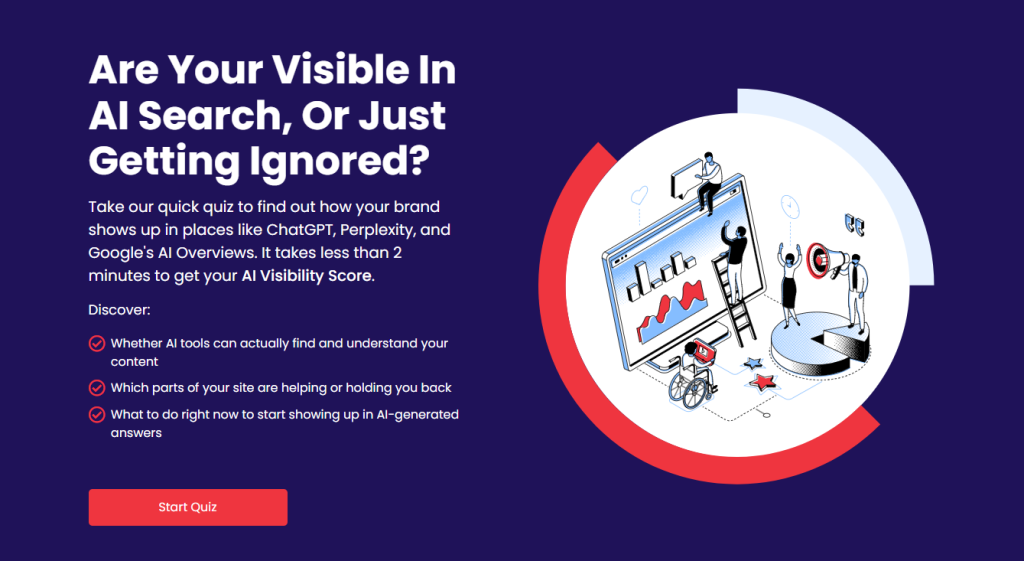Which strategy drives visibility in 2025 AI search? Learn how to get your content found, cited, and surfaced across search engines, voice assistants, and generative platforms.
People don’t search the way they used to. In 2025, you can ask ChatGPT a question and get a full answer before you even think about clicking a link. Same with Google’s AI Overview or Bing’s Copilot. These tools are fast, direct, and they don’t rely on traditional search rankings the way SEO used to work.
That doesn’t mean SEO is dead. But it does mean brands need to adapt. Today, visibility means being part of the conversation. Your content has to be something AI can find, understand, and repeat in a response.
That’s a different challenge than just ranking on a search page.
Let’s walk through the four key strategies every team should understand in 2025:
- SEO: Search Engine Optimisation for Google and Bing
- AIO: AI Optimisation for voice assistants and multimedia inputs
- GEO: Generative Engine Optimisation for showing up in AI-generated answers
- LLMO: Large Language Model Optimisation for getting cited in AI outputs
They’re connected but not interchangeable. Each one addresses a different part of the way people now search and how AI pulls answers.
You May Also Like:
- LLMO Audit Checklist (2025): Diagnose Why LLMs are Skipping Your Site
- Navigating The Four Horizons of Large Language Model Optimisation (LLMO)
- LLMO vs SEO: How to Optimise When AI Disrupts Your Traffic
- AI Search Visibility Strategies For 2025: 10 Experts Share How
TL;DR
| FEATURE | SEO | AIO | GEO | LLMO |
| SYSTEM TARGET | Search Engine Bots | AI assistants, Voice | Generative AI engines | LLMs (GPT-4, Claude, Gemini) |
| FORMAT FOCUS | Web HTML | Audio, Image, Text, Video | Snippets, Summaries, Citation | Embeddings, modular structure |
| SCHEMA USAGE | FAQPage, Product | AudioObject, Speakable | FAQPage, How to WebPage | TechArticle, DefinedTerm |
| TOOLS | Google Search Console | GA4, RSS, Notion | ChatGPT, Perplexity | Langfuse, LLMonitor, Weaviate |
| VISIBILITY METRIC | Rank, Clinks, CTR | Voice inclusion, alt coverage | Cited by AI in answers | Retrieval match, Citation recall |
1. SEO: Your Base Layer
SEO is the foundation. It’s the reason we all care about title tags and backlinks. In 2025, it’s still important because search engines haven’t gone away, and even AI platforms rely on some of the same inputs.
Good SEO helps your pages load fast, makes them easy to read on mobile, and ensures they show up for relevant searches. Google still crawls, indexes, and ranks content the way it always has, though now it layers in AI summaries on top.
What still works well:
- Clean HTML structure with headers in place
- Meta titles and descriptions written for humans
- Backlinks from respected sites
- Fast loading, minimal bloat, solid UX on mobile
What’s different:
- Being first on the page no longer guarantees clicks
- AI-powered features pull text from high-ranking pages, but might not link back
So SEO is necessary, but no longer sufficient. Think of it as the entry ticket, not the entire show.
2. AIO: Making Your Content Understandable to AI
AI Optimisation looks at your content through a different lens. Instead of focusing on how Google indexes it, AIO focuses on how AI tools read, listen, and respond to it.
If you’re creating videos, podcasts, or visual explainers, this matters a lot. AI platforms often skip content they can’t understand quickly, so you need to help them out.
Steps that help here:
- Transcribe audio and video, then link the transcripts on the same page
- Use descriptive alt text for every image
- Add a schema that tells AI what type of media it is (AudioObject, VideoObject)
- Submit your brand to Wikidata or Crunchbase with the right connections
These changes make your content usable across platforms, including voice assistants and AI tools that rely on structured inputs. This isn’t just about visibility anymore; it’s about comprehension.
Think of it like writing for someone with no context who only sees your headline and a short blurb. That’s the AI.
3. GEO: Get into AI-Generated Summaries
Generative Engine Optimisation is about one thing: showing up inside the answer when AI explains something to the user. That might be in a paragraph from ChatGPT, a featured section on Bing, or a Google AI Overview.
Here’s how to make that happen:
- Write content that sounds like answers, not articles
- Use clear questions as headers, like “How does X work?” or “What is Y?”
- Follow with short, digestible responses. Think two to three sentences, maybe a bullet list
- Use a schema like FAQPage, HowTo, or ItemList so AI can parse the structure
Also helpful: posts to sites AI has likely seen during training. Reddit, Quora, and Medium are frequently referenced. Even if your main site doesn’t rank, your post elsewhere might still make it into the answer.
This isn’t about playing to algorithms. It’s about making your content usable by the systems people are now using to get answers.
4. LLMO: Train the Model to Trust You
Large Language Model Optimisation goes deeper than the other layers. It’s not just about visibility. It’s about helping AI learn from your content and reuse it in meaningful ways.
AI models don’t index your site the way Google does. They often pull from structured knowledge, stored embeddings, or high-authority sources. If you want your insights to show up in ChatGPT’s response, they need to exist in a form the model can retrieve or recall.
That means doing things like:
- Splitting content into focused chunks. One idea per section, clearly labelled
- Creating internal links between related concepts. This mimics how knowledge graphs work
- Using schemas like TechArticle, DefinedTerm, and Organization with Wikidata references
- Embedding your content as vectors into databases like Pinecone or Weaviate
- Building a plugin or offering a content feed so AI systems can query you directly
You’ll also want to monitor your presence. Tools like PromptLayer or Langfuse help track how often your brand gets cited or mentioned. And yes, you should ask AI tools what they know about you. If they say nothing, you’ve got work to do.
How to Stack These Tactics
You don’t need to do everything at once. But the more layers you build, the more likely it is that your brand will show up, whether the user is asking Siri, searching Google, or chatting with Perplexity.
Here’s a phased approach that works:
Phase 1: SEO First
Start with what you can control. Run a site audit. Fix broken links. Add schema for your main pages. Make sure your site is mobile-friendly and loads quickly. This is your foundation.
Phase 2: Layer in AIO
Go through your content library. Add transcripts to every video or audio file. Check your images and alt text. Submit your company data to Wikidata and Crunchbase. Create an RSS or JSON feed if you can.
This is how AI systems start to understand and reuse your content across formats.
Phase 3: Apply GEO Techniques
Rework your top pages so they answer real questions. Use numbered steps or lists to make points. Structure answers clearly. Share in public forums and blogs that AI engines scan often. Ask ChatGPT about your brand to see what it knows already.
This boosts your odds of being included in AI-generated answers.
Phase 4: Engineer for LLMO
If you’re ready for a deeper technical layer, chunk your best content and store it semantically. Use a vector database to allow retrieval. Add a detailed schema with entity links. And if you can, build a small plugin or expose your content through an API that models can tap into.
This is the long game. But the results last. Once a model knows your brand, it will keep using it.
Wrap-Up: Getting Found in 2025
People still search. They still browse. But more and more, they’re asking questions in AI interfaces, getting answers immediately, and never visiting a site.
To stay visible in that world, you need to be more than just indexable. You need to be readable, retrievable, and reliable. The four strategies—SEO, AIO, GEO, and LLMO—give you a way to do that.
SEO helps you show up on Google. AIO helps machines understand what you’ve published. GEO gets you into AI summaries. LLMO makes your brand part of the answer itself.
They work better together than alone.
Want Help Implementing All Four?
LangSync AI is a world-leading LLMO agency for the AI era. From audits to schema implementation to vector engineering, we help brands like yours show up across Google, ChatGPT, Bing, and beyond.
Take our free AI Visibility Scorecard to start with a free visibility check.


